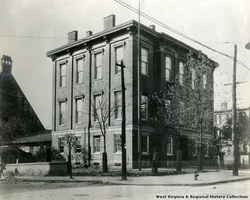 | Back to e-WV
| Back to e-WV
 The West Virginia Encyclopedia
The West Virginia Encyclopedia
 | Back to e-WV
| Back to e-WV
 The West Virginia Encyclopedia
The West Virginia Encyclopedia

Linsly School, an independent, co-educational, college preparatory boarding school located in Wheeling, is the oldest private academy west of the Allegheny Mountains. Incorporated in 1814, the school is named for Noah Linsly, a prominent Wheeling lawyer whose will provided funds for a so-called Lancastrian academy, based on a system using trained older students to tutor younger ones.
Originally located on Chapline Street and open to boys and girls, Linsly soon became an all-boys institution. In 1859, Linsly Institute, as it was then called, erected a new three-story structure, still standing at 1413 Eoff Street. With West Virginia statehood in 1863, government officials leased the building and it served as the first state capitol until 1870. Following the Civil War, the school faced serious financial difficulties, but under the leadership of John Birch, principal from 1874 through most of the late 19th century, the school survived and flourished. In 1877, a cadet battalion was formed, and in 1942 the school became known as Linsly Military Institute. A new building at Thedah Place was erected in 1925, as well as an imposing statue, ‘‘The Aviator.’’ In 1968, the school relocated to the new Banes Hall on Knox Lane. The military program was discontinued in 1979, and in 1988, girls were again admitted.
Linsly School educates approximately 450 students in grades five through 12, with one-fourth boarding students and three-fourths day students. The school expanded under the long-serving headmasters Guy Holden and Basil Lockhart, who collectively served from 1916 to 1972. The current headmaster is Justin Zimmerman.
Written by Margaret Brennan
Ross, Philip. Forward and No Retreat: The Linsly Story. Wheeling: Linsly School, 1994.
Wheeling Intelligencer, 9/1/1859.